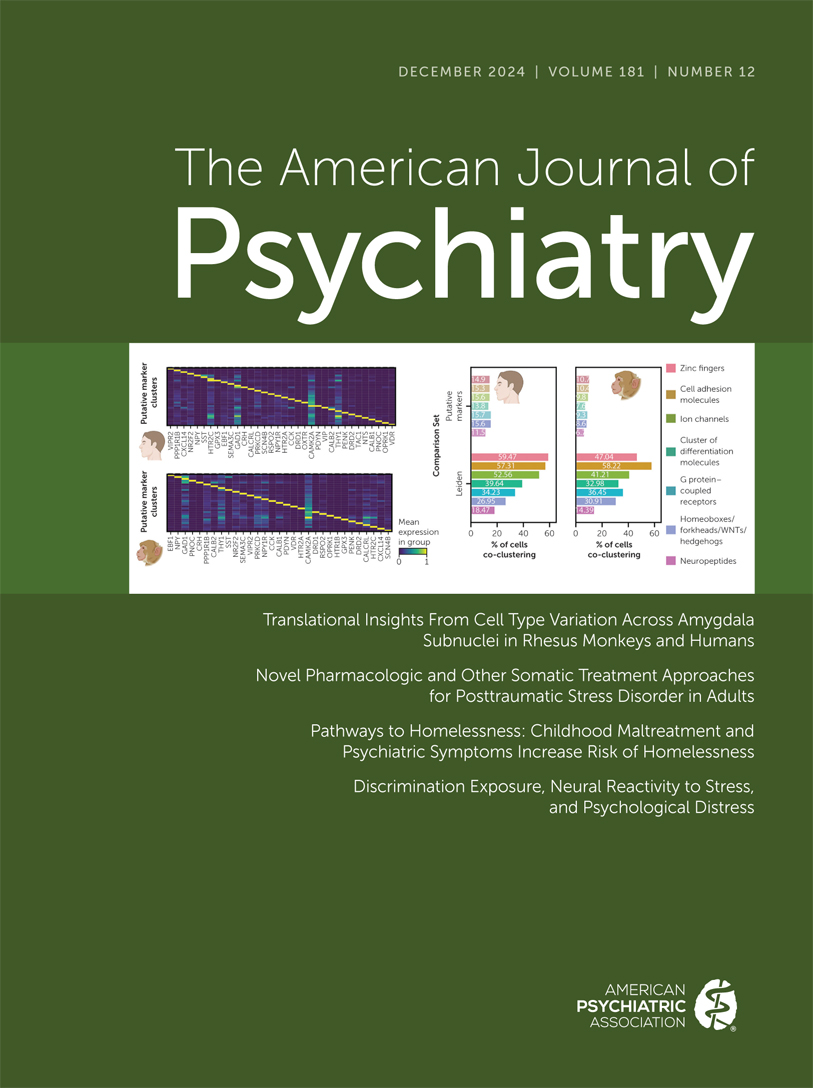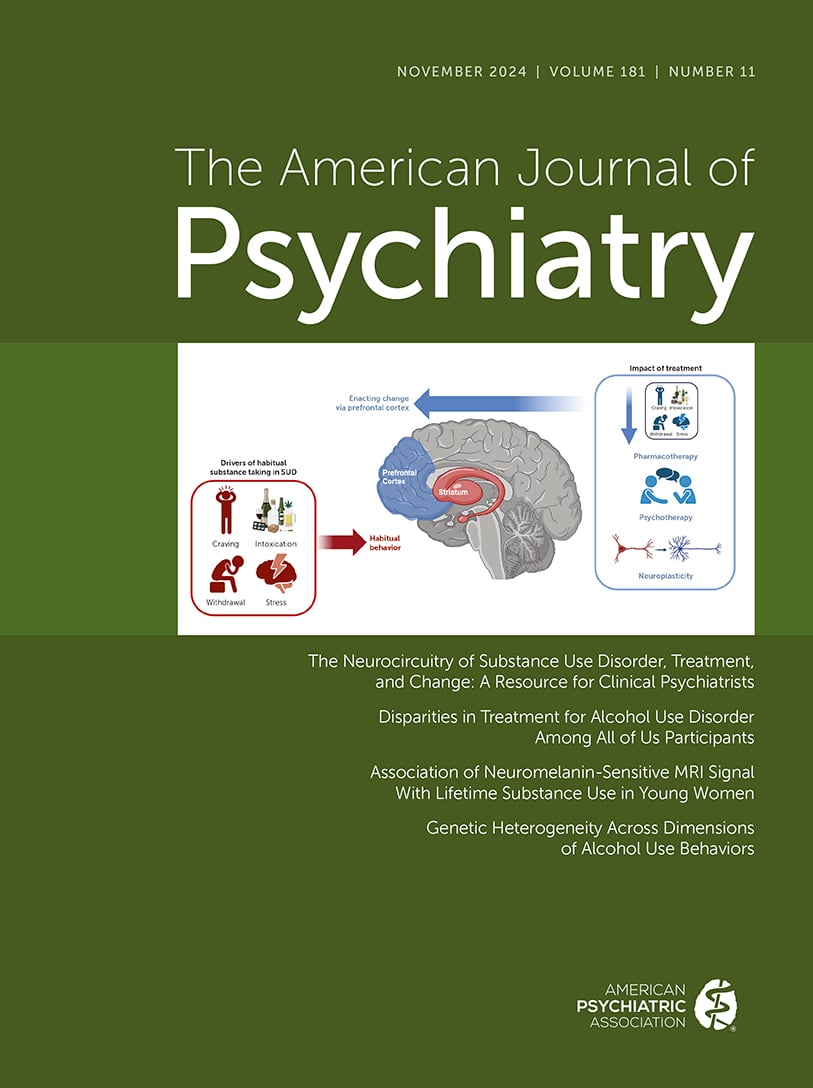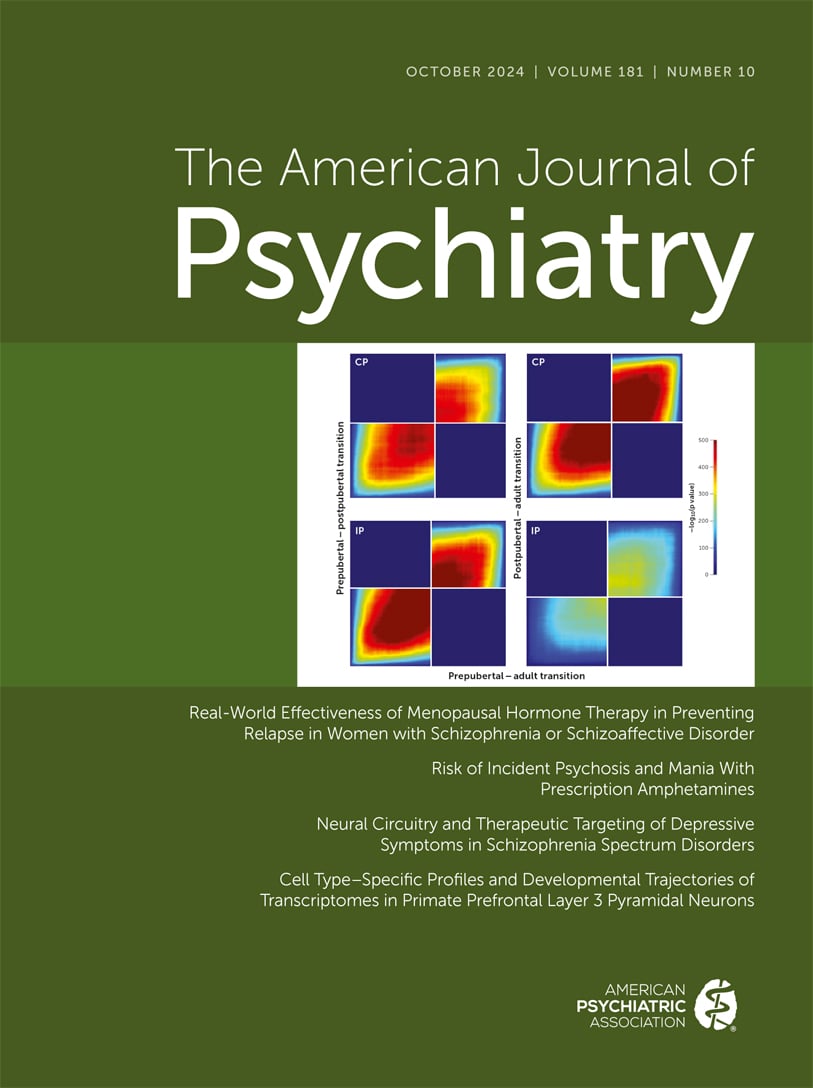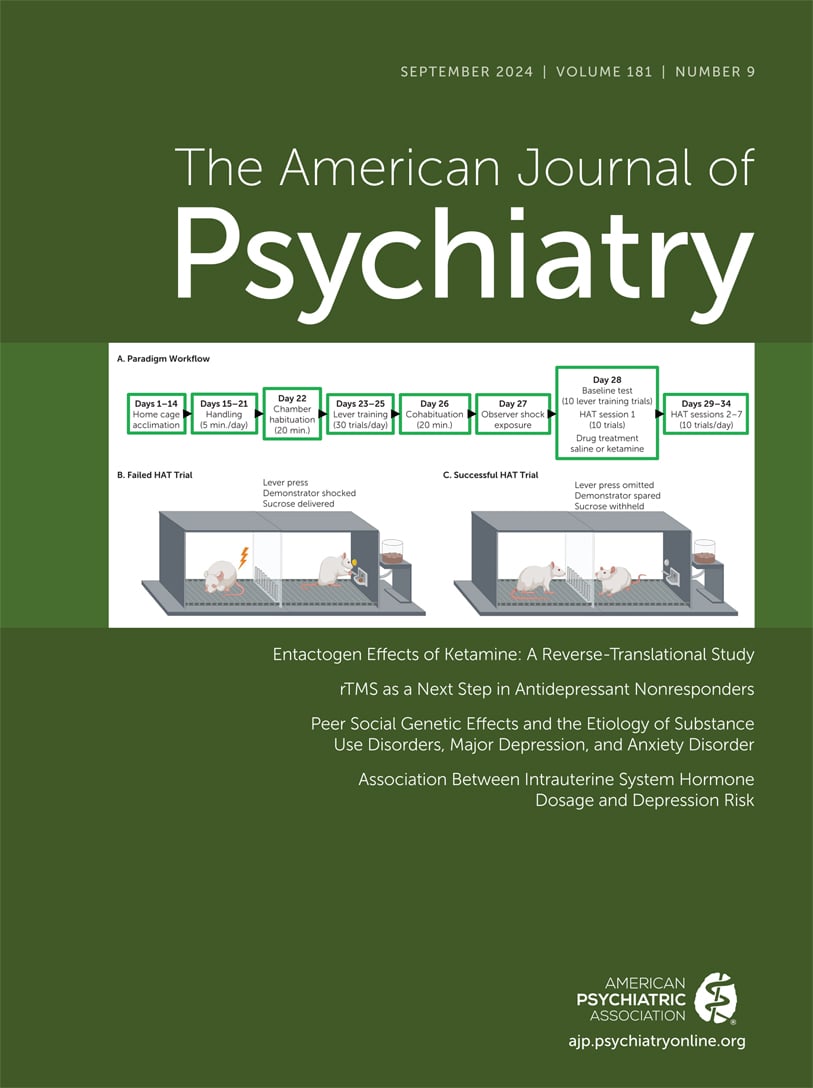American Journal of Psychiatry
- Volume 159
- Number 7
- July 2002
Editorial
Reviews and Overviews
Publication date: 01 July 2002
Pages1080–1092OBJECTIVE: This paper reviews the literature on obstetric complications as a risk factor for schizophrenia. The authors trace the evolution of this literature through different methods and carry out a quantitative review of the results from prospective, ...
https://doi.org/10.1176/appi.ajp.159.7.1080Publication date: 01 July 2002
Pages1093–1102OBJECTIVE: Many clinical syndromes in neuropsychiatry suggest focal brain activation. Repetitive transcranial magnetic stimulation (rTMS) has been proposed as a method for selectively altering neural activity. METHOD: Studies assessing effects of “slow” ...
https://doi.org/10.1176/appi.ajp.159.7.1093Images in Neuroscience
Clinical Case Conference
Images in Psychiatry
Article
Publication date: 01 July 2002
Pages1112–1118OBJECTIVE: Previous work suggests that patients with unipolar depression may have structural as well as functional abnormalities in limbic-thalamic-cortical networks, which are hypothesized to modulate human mood states. A core area in these networks is ...
https://doi.org/10.1176/appi.ajp.159.7.1112Publication date: 01 July 2002
Pages1119–1126OBJECTIVE: The purpose of this study was to characterize the neuropsychological presentation of geriatric depression and to determine whether depression-related executive dysfunction is more pronounced during advanced age. METHOD: The attention and ...
https://doi.org/10.1176/appi.ajp.159.7.1119Publication date: 01 July 2002
Pages1127–1132OBJECTIVE: This study determined the influence of depressive symptoms on subsequent mortality of all causes. METHOD: The Honolulu Heart Program, established in 1965, is a prospective, community-based cohort of Japanese American men living in Hawaii. The ...
https://doi.org/10.1176/appi.ajp.159.7.1127Publication date: 01 July 2002
Pages1133–1145OBJECTIVE: Major depression is a multifactorial disorder with many etiologic variables that are interrelated through developmental pathways. The authors used structural equation modeling to generate a developmental model for the etiology of major ...
https://doi.org/10.1176/appi.ajp.159.7.1133Publication date: 01 July 2002
Pages1146–1154OBJECTIVE: The study assessed the efficacy and safety of risperidone as an adjunctive agent to mood stabilizers in the treatment of acute mania. METHOD: This 3-week randomized, double-blind, placebo-controlled study included 156 bipolar disorder patients ...
https://doi.org/10.1176/appi.ajp.159.7.1146Publication date: 01 July 2002
Pages1155–1159OBJECTIVE: Growing evidence suggests that abrupt lithium discontinuation increases the risk of recurrence for patients with bipolar disorder. To assess the effect of abrupt change in lithium dose, the authors reanalyzed data from a previously reported, ...
https://doi.org/10.1176/appi.ajp.159.7.1155Publication date: 01 July 2002
Pages1160–1164OBJECTIVE: Lifetime rates of suicide attempts among patients with bipolar I disorder were compared to rates during a 2-year period of intensive treatment with pharmacotherapy and with one of two adjunctive psychosocial interventions. METHOD: Subjects ...
https://doi.org/10.1176/appi.ajp.159.7.1160Publication date: 01 July 2002
Pages1165–1173OBJECTIVE: Pharmacological, clinical, and postmortem studies suggest altered γ-aminobutyric acid (GABA)-ergic and glutamatergic function in patients with schizophrenia. The dorsolateral prefrontal cortex is one key locus of abnormality. The precise ...
https://doi.org/10.1176/appi.ajp.159.7.1165Publication date: 01 July 2002
Pages1174–1182OBJECTIVE: Oct-6, a POU-III domain transcription factor, is expressed in embryonic stem cells and Schwann cells and in neuronal subpopulations during early mammalian development, but its relevance to disorders of cerebral development in humans is ...
https://doi.org/10.1176/appi.ajp.159.7.1174Publication date: 01 July 2002
Pages1183–1189OBJECTIVE: Studies suggest the presence of premorbid cognitive impairment in patients with schizophrenia, yet the onset and course of these deficits remain unclear. The purpose of this study was to investigate the longitudinal course of premorbid ...
https://doi.org/10.1176/appi.ajp.159.7.1183Publication date: 01 July 2002
Pages1190–1197OBJECTIVE: “Cognitive” circuits anatomically link the frontal lobe to subcortical structures; therefore, pathology in any of the core components of these circuits, such as in the caudate nucleus, may result in neurobehavioral syndromes similar to those of ...
https://doi.org/10.1176/appi.ajp.159.7.1190Publication date: 01 July 2002
Pages1198–1200OBJECTIVE: The planum temporale, a highly asymmetric neocortical area of the temporal lobe, has a possible role in schizophrenia. The authors used three different anatomical definitions of the planum temporale to examine the anterior, posterior, and total ...
https://doi.org/10.1176/appi.ajp.159.7.1198Publication date: 01 July 2002
Pages1201–1207OBJECTIVE: The degree to which people with psychiatric symptoms and cognitive dysfunction can provide informed consent to participate in research is a controversial issue. This study was designed to examine the capacity of subjects with schizophrenia and ...
https://doi.org/10.1176/appi.ajp.159.7.1201Publication date: 01 July 2002
Pages1208–1213OBJECTIVE: The authors sought to determine the relationship of panic attacks, cigarette smoking, and neuroticism. METHOD: Data were drawn from the Midlife Development in the United States Survey, a representative household survey of the adult population ...
https://doi.org/10.1176/appi.ajp.159.7.1208Publication date: 01 July 2002
Pages1214–1224OBJECTIVE: The authors sought to achieve an improved understanding of the diagnosis of oppositional defiant disorder independent of its association with conduct disorder. METHOD: Family interactions, social functioning, and psychiatric comorbidity were ...
https://doi.org/10.1176/appi.ajp.159.7.1214Brief Report
Publication date: 01 July 2002
Pages1225–1227OBJECTIVE: This study investigated the efficacy and safety of short-term estrogen therapy in decreasing noncognitive signs and symptoms of dementia in demented elderly patients. METHOD: Sixteen moderately to severely demented elderly patients with ...
https://doi.org/10.1176/appi.ajp.159.7.1225Publication date: 01 July 2002
Pages1227–1229OBJECTIVE: Nerve growth factor is important for the development and function of the cholinergic basal forebrain. The authors examined the hypothesis that the concentration of nerve growth factor is lower than normal in the preclinical phase of ...
https://doi.org/10.1176/appi.ajp.159.7.1227Publication date: 01 July 2002
Pages1230–1232OBJECTIVE: The safety and tolerability of short-term treatment with a low dose of risperidone was evaluated in adolescents with prodromal symptoms and a family history of schizophrenia. METHOD: Four prodromal high-risk adolescents and six first-episode ...
https://doi.org/10.1176/appi.ajp.159.7.1230Publication date: 01 July 2002
Pages1232–1235OBJECTIVE: The nature and time course of temporal lobe abnormalities in psychotic illness remain controversial. Confounds include disease chronicity, gender, and handedness. The present study investigated temporal substructures in right-handed male ...
https://doi.org/10.1176/appi.ajp.159.7.1232Publication date: 01 July 2002
Pages1235–1237OBJECTIVE: The authors examined the association between self-reported depressive symptoms in adolescence and mental well-being in early adulthood. METHOD: A questionnaire assessing psychosocial well-being was given to a group of subjects (N=651) in their ...
https://doi.org/10.1176/appi.ajp.159.7.1235Publication date: 01 July 2002
Pages1237–1239OBJECTIVE: Elevated basal cortisol levels are a feature of depressive illness and cause deficits in learning and memory. The adrenal steroid dehydroepiandrosterone (DHEA) has antiglucocorticoid properties that may offer protection against the deleterious ...
https://doi.org/10.1176/appi.ajp.159.7.1237Publication date: 01 July 2002
Pages1240–1242OBJECTIVE: The authors’ goal was to determine if there is an association between brain-to-serum lithium ratios and age. METHOD: Lithium-7 magnetic resonance spectroscopy was used to measure in vivo brain lithium levels in nine children and adolescents (...
https://doi.org/10.1176/appi.ajp.159.7.1240Letter to the Editor
Book Forum: Psychopharmacology
Book Forum: Psychodynamics
Book Forum: Treatment of Depression
Book Forum: Health Care and Patient Information
Past Issues
View Issues Archive
Vol. 181 | No. 12

Vol. 181 | No. 11

Vol. 181 | No. 10
